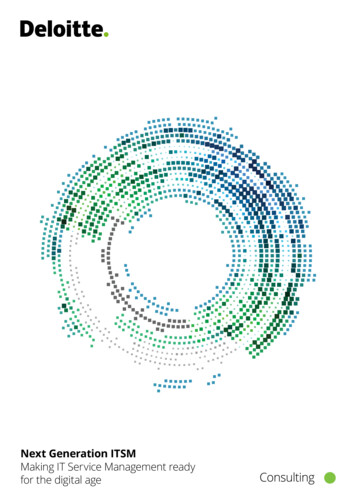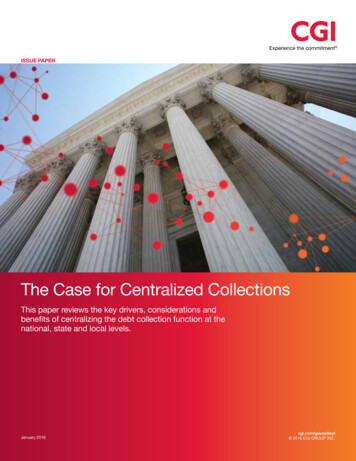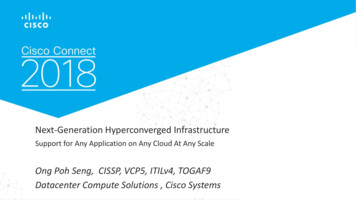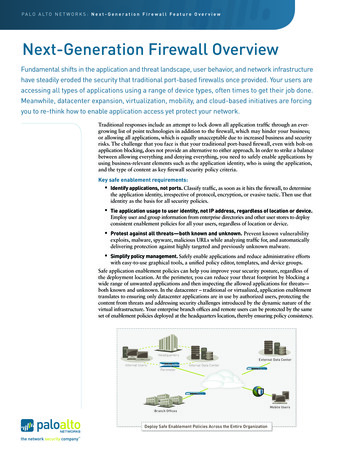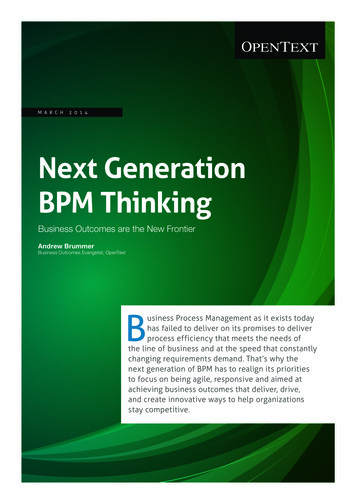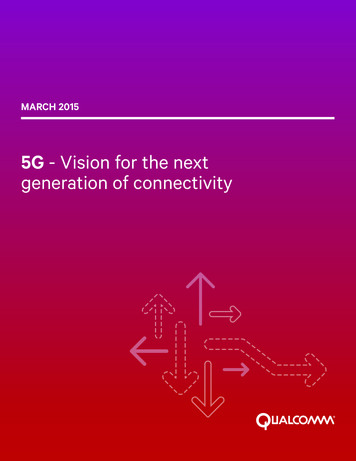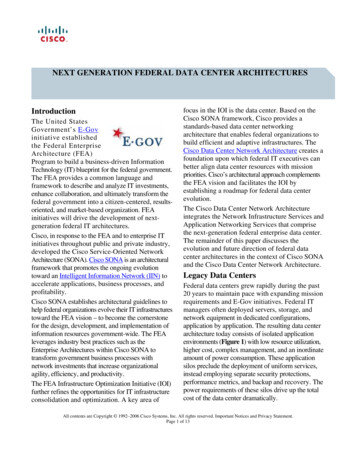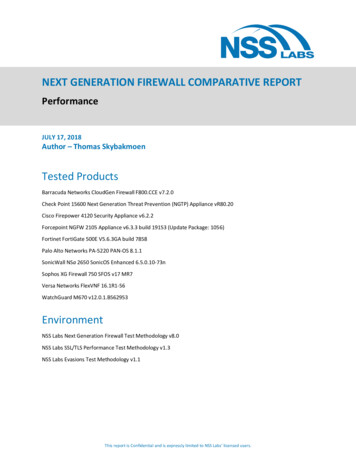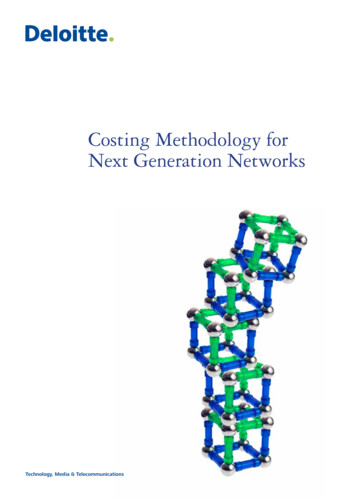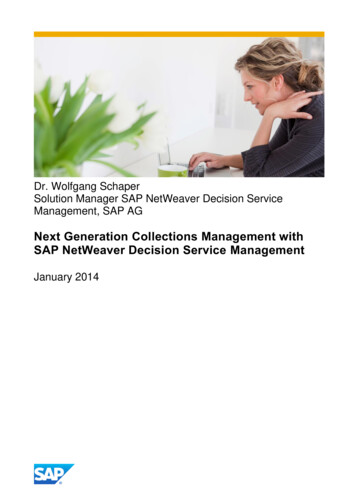
Transcription
Dr. Wolfgang SchaperSolution Manager SAP NetWeaver Decision ServiceManagement, SAP AGNext Generation Collections Management withSAP NetWeaver Decision Service ManagementJanuary 2014
Next Generation Collections Management with SAP NetWeaver Decision Service ManagementTABLE OF CONTENTSIntroduction . 3Use Case . 4Setting up the Decision Service . 5Customize Collection Strategy. 11Run Dunning Proposal . 13Apply Changes to Collection Strategy . 16Resume . 182
Next Generation Collections Management with SAP NetWeaver Decision Service ManagementIntroductionSAP Collections Management permits customer-specific dunning processes with segment-specific collectionstrategies. Depending on the business partners, their payment history, risk assessment, and other factors bedifferent steps may need to be executed in order to minimize the amount of claims that cannot be collected.For adapting collection strategies to changing market situations, legal requirements, and policies it isessential to empower business domain experts to apply changes easily and with no IT expertise. Not beingable to adapt your collection strategies may lead to financial losses, or may even be in violation of the law.SAP Collections Management uses SAP NetWeaver Decision Service Management to define rules fordetermining the next collection step for a business partner in a specific situation.SAP NetWeaver Decision Service Management empowers domain experts to control decision logic withoutassistance from IT, simplifying and accelerating the way logic is implemented and changed across enterpriseapplications.Decision Service Manager provides access to metadata, code, and values (master data, Customizing) tomanaged systems such as CRM or Collections Management for “local” modelling. From the modelledservice, Decision Service Manager compiles anexecutable service on the managed system for localexecution. The managed system does not requireFurther informationupgrades (or support packages); Decision ServiceSAP Collections ManagementManager can be upgraded independently. tservices are safe from upgrades; they are not affectedSAP NetWeaver Decision Servicewhen managed systems are upgraded.ManagementRapid change cycles are in the hands of the domainhttp://scn.sap.com/docs/DOC-29158experts. SAP NetWeaver Decision Service Managementoffers analysing, optimizing, and implementing capabilities:service execution testing, tracing, analytics. No ITinvolvement is required. There is no downtime. And test deployments to any number of systems arepossible. SAP NetWeaver Decision Service Management allows for automated business decisions with fulltransparency for better decision quality.3
Next Generation Collections Management with SAP NetWeaver Decision Service ManagementUse CaseBelow, we will show you how a collection strategy can be set up and changed, and how this affects thedetermination of the next collection step.In our example, there are six different collection steps such as a reminder call or a disconnection notification.These collection steps are defined in ABAP database table TFK047U, which is used in CollectionsManagement. Depending on the last dunning step, the time that has passed since then, the businesspartner’s risk class, the delay, and the existence of open work items the next dunning step needs to bedetermined. For instance, if the last dunning step was sending out a reminder letter more than 8 days ago,the delay is 12 days or more, and if this is not a high risk business partner, we want to trigger a reminder callas the next step. Here you can find an overview of all cases:Last Dunning StepRisk Classnonenone or announcement callreminder letterreminder callreminder callanyany other casenot very highnot very highnot very highnot very highvery highDays in Days Since Open Work Collection StepDelay Last Step Items -2announcement call 4reminder letter 12 8reminder callnodisconnection notification 2yesenforcement work item 4release for external collectionnoneAs we will see later, we can use this exact representation to model the business rules with SAP NetWeaverDecision Service Management.A big benefit of SAP NetWeaver Decision Service Management is to permit central rules maintenance for allsystems in your system landscape, so we will use this capability to segregate design time and runtime.We will apply some changes to the decision making logic, which leads to a different follow on step in thesame situation. We will see how quick and easy it is to adapt these rules.This is not a general introduction to SAP Collections Management or SAP NetWeaver Decision ServiceManagement. For this please see the links offered in the box on page 3.4
Next Generation Collections Management with SAP NetWeaver Decision Service ManagementSetting up the Decision ServiceBefore running the determination of a collections step by SAP NetWeaver Decision Service Management, weneed to set up a decision service. Once this initial step is completed, we can apply changes very easily. Theeasiest way to do the initial setup is to use the BRFplus Workbench (transaction code BRFPLUS) to copy thedefault BRFplus application with all included objects as a template, and transfer it from the collectionssystem to the Decision Service Manager system. This transfer can be done by XML export/import or by usingService Import in Decision Service Manager (transaction code DSM). By doing so, we make sure that adecision service with the same ID is available in both systems. This is needed later for assigning thecollection strategy (see the Customize Collection Strategy section, page 11).There is a function ID and data objects that are part of the delivery of SAP Collections Management. Wecopy all of this to the Decision Service Manager system as described so that we then can alter and deploythe decision service from there. This does not require any changes in the backend application as the sameservice/function ID is used. When deployed, the deployed service is used instead of the local one.To be able to access the backend data of the collection management system, we will assign the applicationto this system. We will do so using Decision Service Manager (transaction code DSM).This assignment establishes a connection to the managed system, permitting access to all backend dataobjects, database tables, and other DDIC objects of the managed system instead of the backend of theDecision Service Manager system.5
Next Generation Collections Management with SAP NetWeaver Decision Service ManagementBy copying the function, we are also making sure that it has the correct signature, which looks like this:All of the input parameters will be filled by SAP Collections Management. The next dunning step is to bereturned in data element E STEP (Collection Step).6
Next Generation Collections Management with SAP NetWeaver Decision Service ManagementA ruleset that contains the actual business rules is assigned to this function. Here you can see a simpleexample that we prepared earlier.7
Next Generation Collections Management with SAP NetWeaver Decision Service ManagementIn the first step, we will determine the risk class of the respective business partner. This is done by adatabase lookup expression that reads from ABAP database table DFKKCMS. Basically we are interested infinding out whether we are dealing with a high risk business partner (risk class ‘D’) or a non-high riskbusiness partner (any other risk class).As we are modelling these business rules in the central Decision Service Manager system, this master datadoes not refer to the local backend, but to the collections system. It is not even necessary for this databasetable to exist in the Decision Service Manager system when a connection from managed system to DecisionService Manager has been established and the imported application is assigned to the managed system.Then all DDIC metadata is taken from the managed system through the connection. For this reason we havealready assigned the application to the managed system.8
Next Generation Collections Management with SAP NetWeaver Decision Service ManagementIn the second, step we determine the next dunning step, which is done using a decision table. Be aware thatthis is only an example. If needed, you can use other expression types or more than one expression todetermine the next step.This decision table has the same structure and the same content as the table describing the scenario onpage 4. It can easily be understood by any business domain expert, who does not necessarily need to be anIT expert.Some of the columns refer to other expressions, such as ‘Days in Delay’ which refers to a formula thatcalculates how many days have passed since the earliest due date of a claim.When the decision service is created and activated, we can deploy it to the collections system. By doing so,we can maintain all collection strategies in a central place, while rules execution is run locally in thecollections management system. Deployment is done with Decision Service Manager (transaction codeDSM). We select the collections system as a managed system and deploy the decision service. This can bedone by any business domain expert, who does not need to have IT expertise. The deployment is performedimmediately without having to wait for a transport cycle or window of opportunity.9
Next Generation Collections Management with SAP NetWeaver Decision Service ManagementIf needed, we also can deploy decision services as of a specific date and time, or apply the deploymentworkflow to implement a customer-specific release process. SAP Decision Service Management providesseveral ready-to-use building blocks such as approval steps, test deployments, automatic tests, and more.10
Next Generation Collections Management with SAP NetWeaver Decision Service ManagementCustomize Collection StrategyTo use these rules in Collections Management, we need to assign them through Customizing (transactioncode SPRO) in the collections system. We can make this assignment by following the path FinancialAccounting (New) / Contract Accounts Receivable and Payable / Business Transactions / Dunning / Dunningby Collection Strategy / Define Collection Strategy. You can apply changes to the business rules later withouttouching or transporting Customizing again.11
Next Generation Collections Management with SAP NetWeaver Decision Service ManagementWe will select the names of the application and the function to be used for a collection strategy. These arethe names of the objects we created earlier in BRFplus Workbench.12
Next Generation Collections Management with SAP NetWeaver Decision Service ManagementRun Dunning ProposalNow it is time to run the dunning proposal. We can do so from SAP menu by choosing Utilities Industry /Contract Accounts Receivable and Payable / Periodic processing / For Contract Accounts /Dunning notice /Dunning Proposal Run. Of course we can also call transaction code FPVA directly in the collection system.13
Next Generation Collections Management with SAP NetWeaver Decision Service ManagementIn the dunning proposal, we enter the date, the identification, and the business partner and run the program(choose ‘Schedule Program Run’ and go for immediate execution).As a result, we get collection step C002 (Reminder Letter). The dunning history can be accessed through themenu Environment / Dunning History.14
Next Generation Collections Management with SAP NetWeaver Decision Service ManagementTo understand how this result was derived, we can switch to the ‘Dunning Parameters’ tab and then choose‘Trace’.15
Next Generation Collections Management with SAP NetWeaver Decision Service ManagementThis brings us to the trace log of SAP Decision Service Management that contains the input parameters andthe result of the rules execution, as well as all of the intermediate steps leading to this result.This trace can be used for error fixing, analytics, archiving purposes, data mining, and much more.Apply Changes to Collection StrategyAssume you need to change your collection strategy. Decision making processes are subject to frequentchanges, which may be an issue when relying on hard-coded decisions, or when they involve transportationmanagement, which requires IT support and leads to significant delays as you need to wait for the nexttransport cycle before any changes are applied to the productive system.16
Next Generation Collections Management with SAP NetWeaver Decision Service ManagementIn this example, we want to replace the reminder letter with an immediate reminder call. To do so, we willchange the second line of the decision table accordingly.After activating and deploying the changed decision service, we see the old version deprecated and replacedby the current version as of the time of deployment.17
Next Generation Collections Management with SAP NetWeaver Decision Service ManagementWhen rerunning the dunning proposal, we see the changed result:Of course you also can apply more complex changes and extensions to the decision logic by changing theconditions, adding new lines to this decision table, or introducing additional business rules and expressions.The basic principle of rules making decisions stays the same.ResumeYou have seen how quick and easy it is to change or extend collection strategies using SAP NetWeaverDecision Service Management. You don’t need IT support to do so, business domain experts can makethese changes themselves. And you have seen how to centrally manage collection strategies across yoursystem landscape and how to deploy them for productive use with just a few clicks.Transferring the template function from the collections system to the Decision Service Manager system is apreparation step that ensure SAP Collections Management can be used with SAP Decision ServiceManagement without any changes or modifications, although SAP Collections Management is much olderthan SAP NetWeaver Decision Service Management. A big advantage of SAP NetWeaver Decision ServiceManagement is its ability to be used with many applications and solutions that never were designed to beused with SAP NetWeaver Decision Service Management. DSM adds unmatched flexibility and agility tothose applications.18
www.sap.com 2014 SAP AG. All rights reserved.SAP, R/3, SAP NetWeaver, Duet, PartnerEdge, ByDesign, SAPBusinessObjects Explorer, StreamWork, SAP HANA, and other SAPproducts and services mentioned herein as well as their respectivelogos are trademarks or registered trademarks of SAP AG in Germanyand other countries.Business Objects and the Business Objects logo, BusinessObjects,Crystal Reports, Crystal Decisions, Web Intelligence, Xcelsius, andother Business Objects products and services mentioned herein aswell as their respective logos are trademarks or registered trademarksof Business Objects Software Ltd. Business Objects is an SAPcompany.Sybase and Adaptive Server, iAnywhere, Sybase 365, SQLAnywhere, and other Sybase products and services mentioned hereinas well as their respective logos are trademarks or registeredtrademarks of Sybase Inc. Sybase is an SAP company.Crossgate, m@gic EDDY, B2B 360 , and B2B 360 Services areregistered trademarks of Crossgate AG in Germany and othercountries. Crossgate is an SAP company.All other product and service names mentioned are the trademarks oftheir respective companies. Data contained in this document servesinformational purposes only. National product specifications may vary.These materials are subject to change without notice. These materialsare provided by SAP AG and its affiliated companies ("SAP Group")for informational purposes only, without representation or warranty ofany kind, and SAP Group shall not be liable for errors or omissionswith respect to the materials. The only warranties for SAP Groupproducts and services are those that are set forth in the expresswarranty statements accompanying such products and services, ifany. Nothing herein should be construed as constituting an additionalwarranty.
SAP Collections Management permits customer-specific dunning processes with segment-specific collection strategies. Depending on the business partners, their payment history, risk assessment, and other factors be different steps may need to be executed in order t
